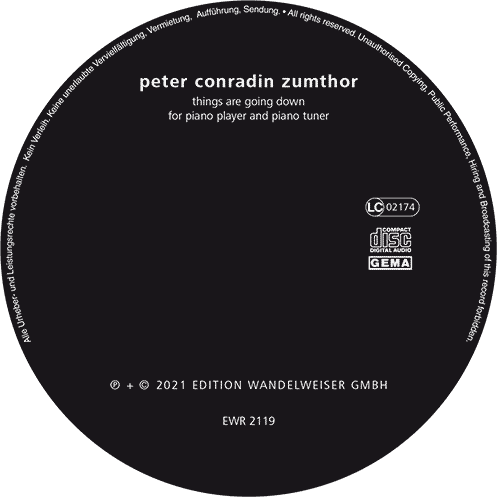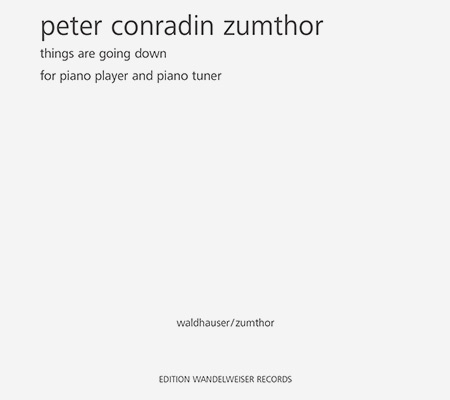EDITION WANDELWEISER RECORDS
> CD catalogue
>> peter conradin zumthor
_____________________________________________________________________
<< >>
peter conradin zumthor
things are going down
| order
reference: medium: composer: performer: |
EWR
2119 CD peter conradin zumthor rené waldhauser (piano tuner), peter conradin zumthor (piano player) |
| |
|

|
 |
|
audio excerpt: ► things are going down (beginning) (10:00) ► things are going down (end) (10:00) peter conradin zumthor (1979) things are going down 1 things are going down (2020) for piano player and piano tuner rené waldhauser (piano tuner) peter conradin zumthor (piano player) songs of shadow zones peter conradin zumthor’s things are going down and the arte povera of sound the first thought while listening: prokofiev! yes, of course – it sounds like the russian composer’s toccata op. 11, which premie- red 1916 in st. petersburg. both pieces feature rapidly repeated octaves, evenly alternating between the great and small octave on the piano. the one note again and again – in this case the b♭ – requiring relentlessly vigourous attack. futurist music appa- rently, the piano as machine. seconds pass, then minutes. but the b♭ remains. for the first four minutes at least, just two octave doublings are added and that’s it – or is it? barely has our impatience abated when perception encounters new horizons: a great throbbing, drumming and roaring emerges round the instrument. the repetitive sounds quake, a cloud of oscillating, singing overtones begins to swell. a steady seesawing between the fifth and the third of the tonic emerges out of its spectrum. while percussionist peter conradin zumthor plays his rapid repeats unfazed for 46 minutes – a total of only five b♭ keys at dif- ferent places on the keyboard – rené waldhauser slowly starts loosening the strings with his tuning hammer. they are using a czech petrof of the 1930s, and the high notes on it are produced with three strings struck simultaneously. however, since the hammers for the two lower notes strike only one or two strings, every modification in the tension of the strings leads to verti- ginous interference between the sound spectra of the lowered strings and those that are still at normal pitch. the layering and acoustic turbulence that will result is near impossible to predict. it takes zumthor and waldhauser 38 minutes for the strings to sag completely until they are left lying slack on the bottom of the piano. from minute to minute, the relati- onship changes between the tonic and its overtones, between the portion of percussive, roaring, rustling, shattering and finally crackling sound. the more relaxed the strings become, the softer the sound. not until approximately the last five minutes does waldhauser begin tightening the strings again almost to their original tautness. thus, the closing section not only shows a rever- sal of the downward drift but also a considerable acceleration of events. zumthor and waldhauser wear glasses to protect them- selves from strings that might snap or come whipping up out of the piano. the idea of a piano player and a piano tuner making music together is not all that far-fetched, but it apparently takes a percus- sionist to delve more deeply into the magical realm of the spectral. zumthor loves the piano. according to the artist from hal- denstein, switzerland, four fifths of his listening repertoire are devoted to piano music. his idol at the keyboard, sviatoslav richter, the legendary russian who died in 1997, "risked so much" and always "preferred to play a wrong note right rather than a right note wrong". however, zumthor, who never studied piano, takes an entirely different tack, exploring diverse facets of the piano, for instance, in musical shorts that he has filmed, such as gartenklavier (2016), muldenklavier (2019) and die letzte stimmung (2021). the piano may be a mighty generator of sound, treated like a melodious percussion instrument. or a lovable, almost nostalgic piece of furniture, now past its prime as an ageing symbol of once so popular bourgeois house music. and of course, a grand piano of the kind that gives any salon the social prestige of a proper concert experience. while in orchestral literature from haydn to varèse to dutilleux, the tuning-up of instruments has often inspired exotic, humorous effects, the tuning of a piano has hardly ever been musically exploited. the 88 keys come into play only after the indispensable specialist has done his job. at the very most, during a concert interval, one might overhear the protracted and relatively uninteresting sound of a tuner regulating microtonal subtleties by adjusting the tension of the strings. nowadays, a piano is properly tuned only if the beats have been banished – viz. pythagorean comma – and all ‘impurities’ eliminated. but these phenomena that lie in what might be called the shadow of musical perception are precisely what motivate zumthor to draw them to our attention with his arte povera of sound. the two friends began experimenting with the old instruments stashed away in the cellar of waldhauser's piano workshop. in the course of their experiments, they discovered that octaves played in quick succession are the best way to make the gradual modifications in sound audible. but how does the coordination between piano player and piano tuner work in a live situation? "we follow the trail together on the basis of my sketches," zumthor explains. "we know more or less when it’s time for the lower or higher registers. the change depends on my state of mind. i need to stop playing octaves periodically to give my ligaments and muscles a rest. at the same time, by putting the tuning hammer on a specific pin, rené can show me which key he wants to change next." the tendency seems obvious: things are going down – downstream. the proud concert instrument of the dazzling soloist has become an anonymous, mechanical device that gradually morphs into a slowly suffocating creature. soon the hammers no longer produce a brilliant prokofiev, nor a melancholy rattling, only a soft crackling and rustling. while the tuner turns the pins, the strain on the piano player and his instrument steadily grows. enormous, unremitting energy is required. then, finally, things start going up again. maybe the end is still open after all – who knows? anselm
cybinski
translation: catherine schelbert |